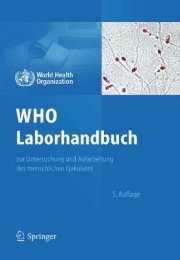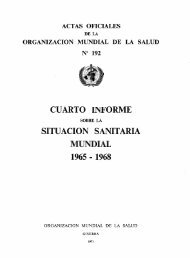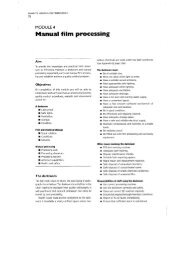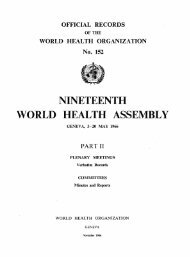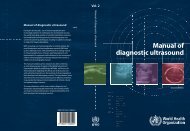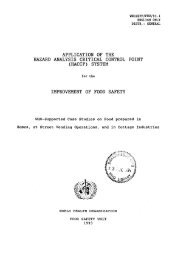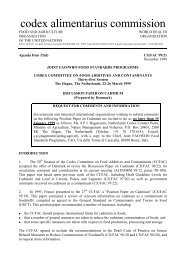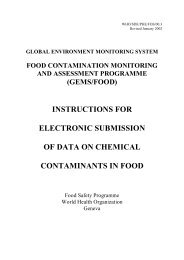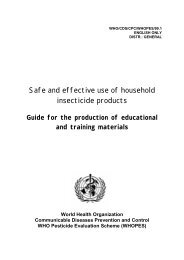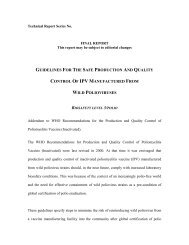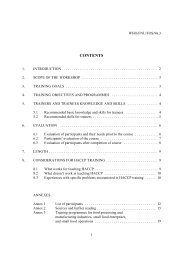WHO Drug Information Vol. 20, No. 4, 2006 - World Health ...
WHO Drug Information Vol. 20, No. 4, 2006 - World Health ...
WHO Drug Information Vol. 20, No. 4, 2006 - World Health ...
You also want an ePaper? Increase the reach of your titles
YUMPU automatically turns print PDFs into web optimized ePapers that Google loves.
Medicines for Tuberculosis<br />
InhA Inhibitors (GlaxoSmithKline–<br />
TB Alliance)<br />
InhA, the enoyl reductase enzyme from<br />
M. tuberculosis catalyses the last step in<br />
the fatty acid biosynthesis pathway (FAS<br />
II). Frontline anti-tuberculosis drugs such<br />
as isoniazid (INH) target this enzyme.<br />
<strong>Drug</strong> resistance to INH results primarily<br />
from mutations in KatG, the enzyme that<br />
activates INH. Consequently, InhA inhibitors<br />
that do not require activation by KatG<br />
are attractive candidates for drug discovery.<br />
The main purpose for this screen is<br />
therefore to bypass the activation step<br />
and directly inhibit InhA. A possible<br />
limitation is that cross-resistance with<br />
isoniazid may occur.<br />
Isocitrate Lyase Inhibitors<br />
(GlaxoSmithKline–TB Alliance)<br />
The isocitrate lyase (ICL) enzyme has<br />
been shown to be essential for long-term<br />
persistence of M. tuberculosis in mice,<br />
but not required for bacilli viability in<br />
normal culture or hypoxic conditions.<br />
Inhibition of the two isoforms of isocytrate<br />
lyase present in M. tuberculosis blocks<br />
growth and survival of M. tuberculosis<br />
bacteria.<br />
The absence of ICL orthologs in mammals<br />
should facilitate the development of<br />
glyoxylate cycle inhibitors as new drugs<br />
for the treatment for tuberculosis. Such a<br />
new drug is expected to be able to kill<br />
persistent bacteria and therefore have<br />
sterilizing activity and shorten treatment<br />
time. However, the structure of ICL active<br />
site is making the screening for inhibitors<br />
particularly lengthy and laborious.<br />
Compounds originating from<br />
existing families of drugs<br />
Other promising candidate anti-TB drugs<br />
include: Gatifloxacin, Moxifloxacin,<br />
Diamine SQ-109, <strong>No</strong>n-Fluorinated<br />
Quinolones, Nitrofuranylamides, Picolinamide<br />
Imidazoles, Thiolactomycin<br />
Analogs, Dihydrolipoamide Acyltrans-<br />
244<br />
<strong>WHO</strong> <strong>Drug</strong> <strong>Information</strong> <strong>Vol</strong> <strong>20</strong>, <strong>No</strong>. 4, <strong>20</strong>06<br />
ferase Inhibitors, Methyltransferas inhibitors,<br />
and Quinolones.<br />
Timeline for development<br />
of candidate drugs<br />
Clinical trials to register a TB drug represent<br />
a lengthy and expensive process<br />
that can take a minimum of six years,<br />
generally longer than for other infectious<br />
diseases. The greatest challenge in the<br />
design of TB clinical trials is in Phase III<br />
Trials. These trials are usually large<br />
scale, randomized clinical trials designed<br />
to show improvement or equivalent<br />
efficacy compared to the standard<br />
regimen among diseased patients.<br />
Efficacy evaluation requires measurements<br />
of relapse rate during a 1–2 year<br />
follow-up after completion of the already<br />
lengthy 6-month treatment regimen.<br />
Relapse rate after chemotherapy is<br />
commonly accepted as the endpoint to<br />
determine the efficacy of a new therapy<br />
and to assess whether a new drug<br />
can improve sterilizing activity. Since<br />
relapse rates under random clinical trial<br />
conditions are often 3% or less, large<br />
numbers of patients are needed to<br />
demonstrate an improvement in relapse<br />
rate. This results in high drug development<br />
costs and long delays in introducing<br />
new medicines.<br />
Regulatory agencies require that efficacy<br />
is demonstrated during phase III trials<br />
involving a combination of traditional and<br />
surrogate markers for activity. Since the<br />
identification of biomarkers could significantly<br />
streamline and accelerate clinical<br />
development, the TB Alliance has recently<br />
established a collaboration with BG<br />
Medicine Inc. to identify biomarkers for<br />
drug efficacy in TB treatment. Validated<br />
surrogate markers of relapse could<br />
provide evidence on the efficacy and the<br />
sterilising activity of a drug/regimen<br />
without requiring large numbers of patients.



